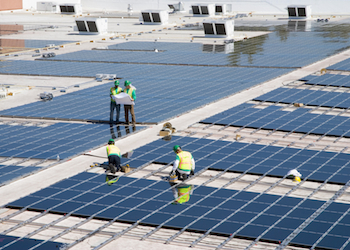
 Thin film solar company Solyndra recently became the third big U.S. solar company to declare bankruptcy this quarter.
Thin film solar company Solyndra recently became the third big U.S. solar company to declare bankruptcy this quarter.
Given its Department of Energy (DOE) backing and Silicon Valley factories, Solyndra's demise is big news: Republican pundits are using it as the poster child for the failure of Obama's stimulus act. Meanwhile, polysilicon prices are falling, which pushes Solyndra's competitors' products closer to grid parity and makes large solar installations more feasible for utility and enterprise buyers.
Lost amid the circus of congressional hearings, as both parties try to score political points over Solyndra, is a far bigger issue: Should the government invest in single companies and technologies or set a broad regulatory framework through an economy-wide cap-and-trade market, carbon tax, or other mechanism to put a price on harmful greenhouse gas emissions? That would level the playing field between renewable energy companies and fossil-fuel competitors and allow the market to choose the best green technologies and business models. But neither the Obama administration nor Congress has shown any political will to do that. Thus we have the policy of individual loan guarantees and the resulting political fallout when a startup fails in a volatile market.
One bad apple: The biggest impact the Solyndra case could have would be to undercut Democratic support for extending the renewable energy loan guarantee program. It could also undercut support for green technology initiatives in general.
Win some, lose some: I think the fact that venture capitalists invested more than a $1 billion into Solyndra and will likely lose their money has been an overlooked aspect that illustrates the disconnect between Washington and Silicon Valley. Private investors make such bets all the time, knowing that there's a good chance that new technologies in volatile markets may well fail.
Read more
The big drop in solar panel prices this year — around 25 percent — is largely a result of declining government incentives in key markets such as Germany and Italy. Those incentives, meant to encourage installations, expand production, and lead to cheaper solar electricity, are set to decrease over time, but they don't necessarily fall in predictable ways. Meanwhile, many manufacturers, bullish on the long-term prospect of the solar market, have been building factories quickly in the past two years. This enabled them to lower their prices when demand fell earlier this year. They've been posting declining profits or even losses but have enough money to weather the tough times. Manufacturers that couldn't lower their costs quickly enough or sell their products effectively became weaker. In the past month and a half, we saw three American solar companies file for bankruptcy: Evergreen Solar, SpectraWatt, and Solyndra.
Blame China: Chinese manufacturers, with big loans from government-run banks in China, have expanded production and lowered prices. Americans who criticize the U.S. government for using public money to support manufacturers seem to have forgotten that our banks haven't been all that willing to lend big sums of money in the past two years.
Criminal failure? Solyndra is under investigation by the Department of Energy and Congress. It's unclear what laws it may have violated, but some allege that Solyndra's CEO, Brian Harrison, was trying to cover up financial troubles when he assured legislators just a few months ago that the company was doing fine.
Read more
In some ways, the Solyndra bankruptcy can be viewed as more significant than other recent solar bankruptcies for one simple reason: Solyndra was the first recipient of an Energy Department loan guarantee, an award announced with great fanfare in early 2009. As such, the company was viewed as a sign of bigger things to come. The company's firing of 1,100 workers and bankruptcy filing has instead cast a sharp glare upon the loan guarantee system. What remains to be seen is whether critics will use Solyndra's failure as a reason to push back against other green energy initiatives and whether the government will learn from its mistakes. Either way, this case study carries real resonance for the industry and for its government backing.
Achtung, baby: Red flags on this project were abundant. They came from rating agencies, solar analysts, government auditors — and even Solyndra's own accountant. And we now know that staffers within the DOE and the Office of Management and Budget were also issuing pointed warnings. But the government pressed forth, raising a question: Why choose such a risky bet for the first loan guarantee?
What's next? The Treasury Inspector General has opened an inquiry into the government bank loan to Solyndra. The House committee continues to scrutinize the award, and the FBI and Energy Department inspector general continue their investigation. For the public, the biggest issue may be in bankruptcy court, where creditors — including the United States — will line up in a bid to recover some of their money.
Read more
- Skipping Safeguards, Officials Rushed Benefit to a Politically Connected Energy Company [By Ronnie Greene and Matthew Mosk, iWatch News]
- White House Budget Office Raised Risk on Big Solar Loan Guarantee [By Ronnie Greene and Jeremy Borden, iWatch News]
- Obama-Backed Solar Firm Collapses After Big Federal Loan Guarantee [By Ronnie Greene and Matthew Mosk, iWatch News]
| Tweet This Page |












